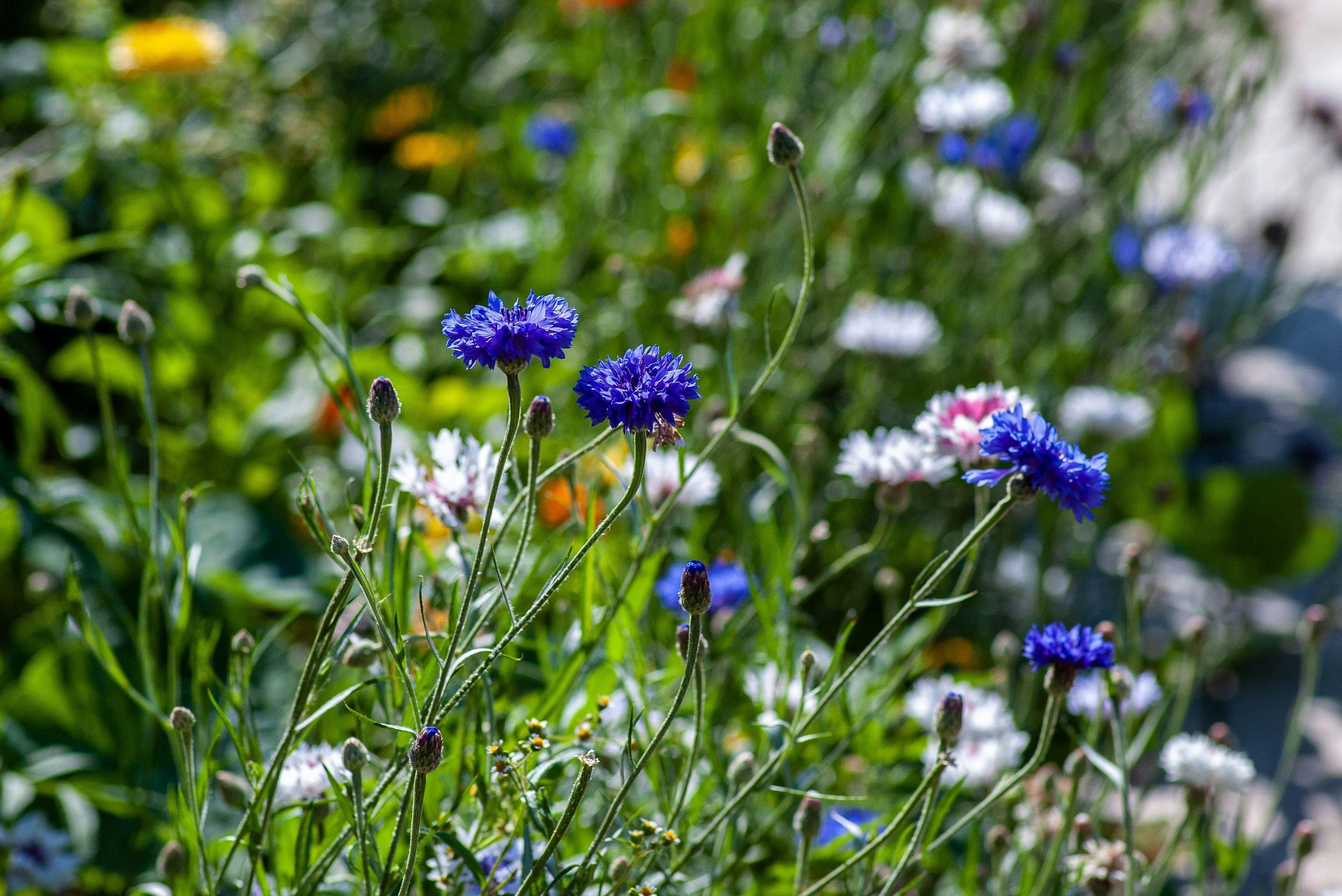
Roll up your sleeves and get ready to tidy up and prune those spring plants, while joyfully planting a colourful assortment of flowers and veggies for the summer. And hey, why not have a little fun filling in any empty spots in your garden too? May is all about embracing the energy and making your garden truly shine. So let's get out there and create a blooming paradise!
cut flowers + nectar flowers
Sowing and Growing:
- Plant out your greenhouse-grown plants, ensuring they're well established and hardened off. Use straw or newspaper as ground cover for protection from late frosts.
- Thin out hardy annuals, giving them around 30cm of space to promote better growth. Plants like cornflowers, nigella, and cosmos thrive with more room.
- Directly sow biennials like wallflowers, forget-me-nots, and foxgloves for establishment before winter.
- Fill gaps in borders with bedding plants such as Salvia. Water them regularly, especially in dry weather.
- Directly sow poppies, which will flower within 8 weeks. Avoid transplanting to minimize root disturbance.
- Deadhead spent flowers to encourage a second bloom. This is especially effective with annuals for seed production.
- Pull out spring bulbs or divide clumps like snowdrops and daffodils.
- Stake dahlias and other heavy blooms as they grow.
- Enjoy picking lilies, alliums, sweet peas, peonies, and more from your garden in June.
Perennials Pruning & Tidying
Here are some tips to keep your garden in shape and promote healthy growth:
- Keep weeding and deadheading for a beautiful border. Use mulch on moist soil if not done in spring. Handle aphids with soap-based water if necessary.
- Prevent wind damage by staking and tying taller perennials. Metal supports and flower rings work well for vulnerable plants like delphiniums and peonies.
- Divide primulas, including primroses and cowslips, for rejuvenation.
- Cut oriental poppies back to ground level after flowering. Feed, mulch, and water for new foliage growth.
- Trim delphiniums to the ground, including leaves and old flower spikes, for a second bloom later in the season.
- Prune sedums to prevent sagging. Trim stems by about a third.
- Take cuttings of lavender for propagation.
- Deadhead roses to promote further flowering. Trim browning heads to a bud or leaf below.
Garden Greens
Here are some tips for your kitchen garden to ensure a bountiful harvest: Vegetables:
- Direct sow brassicas and leeks for a winter harvest.
- Plant beans and tomatoes at the base of prepared supports, ensuring well-watered roots.
- Pinch-out side-shoots of tomatoes and support them with canes for regular tying.
- Try a second sowing of courgettes, planting in pairs and removing the weaker seedling.
- Continue successional sowings of carrots, French beans and sugar snap peas.
- Direct sow chicory for winter meals, thinning seedlings and transplanting later for proper spacing.
- Enclose carrot beds with insect protection to deter carrot flies.
- Tie in cucumbers and tomatoes to support and practice companion planting with edibles and flowers.
Salad & Garden Herbs:
- Keep successional sowings of radishes, lettuce, and salad leaves.
- Sow herb seeds such as coriander, parsley, chives, and dill.
- Direct sow basil, watering regularly for germination.
- Grow mint stems in water to establish roots before planting them in pots to contain the spread.
By following these tips, your kitchen garden will thrive with a variety of delicious vegetables, fresh salads, and flavourful herbs.
Harvesting:
- Gather your brassicas, including calabrese, spring cabbage, and kale.
- Harvest a variety of roots like radishes, carrots, baby beetroot, and autumn-sown onion sets.
- Pick salad crops such as salad leaves, pea tips, and different lettuce varieties.
- Add a touch of beauty to your dishes with edible flowers like borage and marigolds.
- Enjoy leafy greens like chard and perpetual spinach.
- Savor the first peas and broad beans from your garden.
- Pick the first outdoor courgettes and globe artichokes.
- Harvest herbs, which should be flourishing in June.
- Keep an eye on the ripening rhubarb, strawberries, cherries, and redcurrants.
Odd Jobs
- Maintain your pond by removing excess pondweed using a small net or sieve.
- Ensure your fish are well-fed as they become more active in warmer temperatures.
- Plant your summer and autumn-flowering containers, combining upward and trailing plants for a stunning display.
- Keep your lawn neat by mowing and edging it.
- Water your containers and hanging baskets daily to prevent dryness.
- Take cuttings from various plants and provide thorough watering for successful rooting.
- Properly manage your greenhouse by opening vents and doors, using blinds or shade paint, and maintaining humidity.
- Stay vigilant against pests like vine weevil and woolly aphid, taking necessary control measures.
- Encourage beneficial insects by diversifying your garden with a variety of plants.
By following these tasks, you'll enjoy a fruitful harvest and create a thriving garden environment. Remember to water, stake tall plants, control weeds, top up bird baths, and deadhead spent flowers for a flourishing garden.